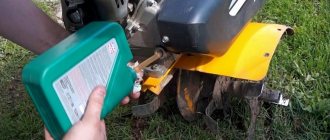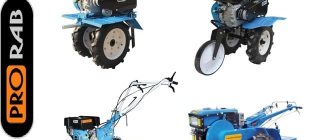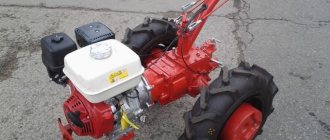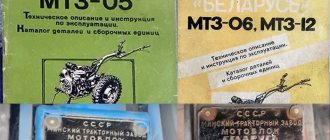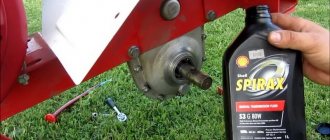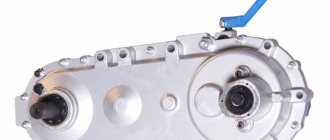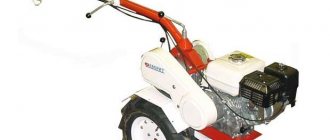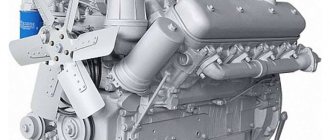A modern walk-behind tractor consists of many mechanisms, which require lubricant for proper and coordinated operation. Not only the durability of the unit’s elements, but also the effectiveness of its use in certain conditions depends on the quality and properties of the latter.
It’s not for nothing that the motor is called the “heart” of the walk-behind tractor. The performance of the unit largely depends on the condition of the first. The engine, in turn, will not be able to operate without properly selected engine oil.
The latter performs several important functions at once:
- cools the walk-behind tractor engine under heavy loads;
- lubricates the rubbing parts of the engine;
- cleans the internal cavities of the engine from blockages;
- compacts the fuel mixture, making it of higher quality.
During operation of an air-cooled engine, the lubricant used evaporates and accumulates on the surface of the hot cylinder. As a result, the oil along with the fuel turns into smoky exhaust gases. All fuel combustion products collected on the parts of the walk-behind tractor significantly complicate their lubrication. To prevent this, many companies that produce walk-behind tractors advise using special antioxidants along with lubricants, the task of which is to clean engine parts from harmful deposits.
All commercially available motor oils are divided among themselves according to the SAE system.
According to it, the following lubricants are distinguished on the market:
- summer oils – these products are intended for use primarily in the summer. They have a high viscosity, and there are no letter markings on their packaging. These compositions include SAE 20, SAE 30, SAE 40;
- winter oils - materials of this type are used to lubricate walk-behind tractor engines in the winter. They are characterized by low viscosity and the presence in the marking of the letter W, which stands for “Winter”. Winter oils include SAE 0W, SAE 10W, SAE 20W;
- all-season oils - these compounds are in the highest demand. They are universal, as they can be successfully used in both winter and summer. Their packaging is double labeled. These oils include 5W-30 and 10W-40 formulations.
To choose oil for a walk-behind tractor, you should also consider its composition.
Manufacturers produce lubricants for engines with the following compositions:
- synthetic oils;
- semi-synthetic compounds;
- mineral oils.
You can also find oils on the market for both 2-stroke and 4-stroke engines. Most modern walk-behind tractors are equipped with 4-stroke engines with built-in air cooling systems. Such engines should only be filled with 4-stroke oil.
A forced air-cooled motor heats up significantly more during operation than an active water-cooled motor. In this regard, the oil in a walk-behind tractor with such a cooling system must have high thermal-oxidative stability and fairly low volatility. In addition, the oil used to lubricate the engine must certainly meet all known modern environmental requirements, in other words, show the permissible level of toxicity of emitted exhaust gases and smoke.
Oil for a diesel walk-behind tractor - what should you remember when choosing?
According to API standards, lubricating compounds are divided into three types - for gasoline engines, for diesel engines and universal oils, which can be used for all types of internal combustion engines.
If you use gasoline for a walk-behind tractor when refueling, then to lubricate the engine you will need to buy motor oil, the packaging of which contains a two-letter marking. The first letter must be the letter S, and the next one must be one of the letters A, B, C, F, G, H or J. If diesel fuel for a walk-behind tractor is used for refueling, then in order to lubricate the engine, you must buy the oil on the packaging of which the first one must be the letter C is indicated.
Universal motor oils are designated by double marking, which indicates the possibility of using both types of internal combustion engines for lubrication. Such motor oils, for example, may be marked with the inscriptions SG/CD or SF/CC.
SAE Technical Classification
SAE is one of the most common classifications. It was developed by the American Association of Automotive Engineers (“Society of Automotive Engineers”). In the process of creating the classification, the viscosity and fluidity of the substance in a certain temperature range were taken into account. According to the SAE J300 standard, the following types of oil exist:
- Universal: 5W-30, 5W-50, 5W-50, 15W-30, 20W-30, 10W-50, 10W-30, 10W-40, 15W-50 15W-40, 20W-40;
- For cold climates: SAE 0W, 10W, 15W, 5W,20W;
- For warm climates: 50, 40, 30, 20.
All-season brands are in greatest demand among the population. The great demand for such products is explained by the ability to use them in any climatic conditions. The liquid has optimal performance characteristics all year round in almost any climate zone.
Is it necessary to add oil to gasoline for a walk-behind tractor?
This important question interests the vast majority of beginning farmers. Before answering this question, it is necessary to study the technical characteristics of the walk-behind tractor available on the farm, and specifically the clock cycle of its engine. According to this feature, all internal combustion engines are divided into 2-stroke and 4-stroke.
The fuel mixture of fuel and engine oil should only be poured into 2-stroke engines. In the process of preparing it, you must strictly adhere to the proportion specified by the manufacturer in the walk-behind tractor operating manual supplied with the kit. When refueling walk-behind tractors powered by 4-stroke engines, this procedure is not necessary, since the operation of 4 strokes of such engines is supported by pure gasoline.
It should be remembered that to refuel diesel walk-behind tractors, you cannot dilute diesel with engine oil, since all such engines belong to the class of 4-stroke internal combustion engines. If you do not follow this rule and fill a 4-stroke engine with a mixture of fuel and motor oil, this will inevitably lead to engine failure, resulting in the need for expensive repairs.
Model range of Caiman cultivators
The models under consideration are semi-professional and professional.
Petrol cultivator Caiman Eco Max 50S C2
Petrol cultivator Caiman Eco Max 50S C2
Very popular among both agricultural enterprises and farmers. Easy to manage and does not take up much space. Designed for a large number of canopies. Its key characteristics:
- Powered by a four-stroke Subaru-Robin EP16 OHC engine (power - 5 hp) with a volume of 160 cc. cm.
- The gas tank holds 2.7 liters of fuel.
- When working, you can capture from 30 to 60 cm of soil in width and 32 cm in depth.
- Cultivator weight - 46 kg.
- Single-speed gearbox (1 reverse and 1 forward).
- Razor Blade cutters.
- Height-adjustable handles.
Is it possible to fill a walk-behind tractor with motor oil?
Ignorance of the answer to this question often becomes the reason for the breakdown of almost new agricultural machines. The answer to this is quite simple - under no circumstances should you use automobile oil to lubricate the engine of a walk-behind tractor.
The thing is that the lubricant produced for a walk-behind tractor engine and the product for a car engine are liquids of different compositions. Each of them has its own temperature conditions, as well as the principles of lubrication itself. In walk-behind tractor engines, motor oil spreads by splashing, so for such engines it is necessary to use lubricants that contain special additives. Otherwise, the walk-behind tractor engine will quickly fail.
Who were the Vikings and what happened to them: History of the Vikings
Scary, ruthless, noble, cruel, experienced, respected. These and many other words can describe the Vikings. For a time, these proud warriors dominated everyone else in their part of the world.
READ Installing an Engine From a Motoblock to an Ant
But who were the Vikings? Where did they come from and what ultimately happened to them?
These questions and many more will be the focus of this article as we delve into the rich history of Viking society and its people.
Come here
Walk-in's used to be made in America. Gravely was the largest American manufacturer of walk-behind tractors, and several other American companies made them since the early 1900s. But the larger tractors produced after World War II dried up the market for many tractors, and even Gravely stopped making them around 2003.
American manufacturers have also never introduced much innovation in this equipment sector. even in the final days of their production, Gravely still did not have ambidextrous handlebars. while Europeans adopted this extremely practical design in the 1960s. Now almost all walk-behind tractors are made in Europe, mainly in Italy, which has more than 15 brands. Two Italian brands that can be found in North America. these are BCS America (based in Portland, Oregon) and Grillo, with BCS being the best known as they have been imported since the mid-1970s.
Step 8:
Wait about one minute for the oil to settle.
What language did the Vikings speak?
As the Vikings traveled the world, they were forced to communicate with completely different peoples and therefore different languages. However, in their homeland, the Vikings spoke a language known today as Old Norse.
Old Norse was a North Germanic language spoken throughout much of the Scandinavian region, including the Faroe Islands, Iceland and Greenland. There were regions in parts of Russia, France, the British Isles and Ireland that also spoke Old Norse, which is not surprising given the strong Viking influence these regions were under during that time period.
Historians have discovered many ancient runes and carvings that reveal the use of Old Norse. The runic script is known as Younger Futhark or Norse runes. It is a runic alphabet consisting of 16 characters and was used primarily during the Viking era, gradually disappearing as their power and influence began to wane.
Motor oils for walk-behind tractors of popular brands
Certain motor oils may be suitable for lubricating the engines of various walk-behind tractors. Let's look at which lubricants comply with the instructions of the most popular engine manufacturers for agricultural machinery.
Subaru
These engines are often included with Centaur and Zubr engines. To lubricate them, it is optimal to use synthetic or semi-synthetic oil SAE 30 in summer, and universal lubricant SAE 10W-30 for winter use.
Briggs&Stratton
To operate these popular American engines, which are equipped with the Neva MB-1, MB-2 walk-behind tractors and other popular units, you should use Briggs&Stratton 10W-30 branded semi-synthetic motor oil. Such engines consume a large amount of engine oil, so during their operation it is very important to regularly check the presence and volume of lubricant.
Honda
For lubrication of Honda engines, it is optimal to use SAE 10W-30 oil. It is suitable for use in both summer and winter. The packaging of the lubricant used must be marked SF or SG.
Lifan
These motors for walk-behind tractors appeared relatively recently, but are already very popular among gardeners and commercial organizations involved in agriculture. Let's consider the main characteristic features of these motors:
- products are available in various capacities;
- there are both diesel and gasoline units here;
- motors have a long service life;
- moderate power and operating speed;
- fairly low cost of the devices;
- the versatility of these devices;
- improved thrust of Lifan engines;
- compact dimensions (motors are easy to install).
Also, these installations are not highly voracious during frequent use (the engines do not consume large amounts of fuel or oil, compared to other similar models from other manufacturers).
Important! Despite the large list of qualities of such power plants, the models appeared on the Russian market relatively recently, which is why they are not widely used. Also, during operation, it is necessary to monitor the condition of the spark plugs; there are often cases when they are flooded.
Another manufacturer of power plants for Salyut brand walk-behind tractors. These units are in great demand. They are characterized by the following distinctive features:
- moderate power and operating speed;
- relatively low cost of devices;
- long service life of motors;
- availability of all consumables and spare parts for free sale;
- unpretentiousness to Russian fuel;
- engines do not consume large amounts of oil;
- relatively small size of power plants;
- Due to the motors, good cross-country ability is ensured.
Despite the large number of positive aspects, when operating these motors you can also encounter some disadvantages. The most pronounced disadvantage is the high cost of spare parts (in order for the engine to last a long time, consumables need to be changed quite often).
It is worth noting that not all brands of motor units for Salyut walk-behind tractors were considered here; there are also other manufacturers of power plants, however, their characteristics and performance are somewhat worse than those of the models mentioned here.
ACME is relatively inexpensive
Changing the oil in a walk-behind tractor engine - in detail for beginners and not only
Before you begin directly changing the engine oil, you should study the walk-behind tractor manufacturer's instructions on the frequency of lubricant replacement. If there are no operating instructions, then the composition is replaced using a method common among farmers.
For the first time, you should definitely change the engine oil for a walk-behind tractor immediately after the new unit has been fully run-in. The break-in itself should be carried out exclusively with the engine idling, after making sure that there is a sufficient amount of lubricant in the crankcase.
After the first hour of operation, perform the first oil change. The second replacement should be performed no later than after 6 hours of using the walk-behind tractor. In the future, you will need to change the used motor oil in the walk-behind tractor engine approximately every 40 hours of operation of the unit.
After storing the walk-behind tractor for the winter, you also need to change the engine oil. It does not matter how long the agricultural machine has been in use - at the first signs of darkening, increased viscosity and a strong burning smell, the engine lubricant must be replaced.
To quickly change the oil in a walk-behind tractor engine, you need to follow this sequence:
- First of all, you should warm up the motor of the walk-behind tractor - this will increase the fluidity of the oil;
- After this, the walk-behind tractor must be installed strictly in a horizontal position;
- Next, you need to unscrew the cover of the drain plug located in the lower part of the walk-behind tractor crankcase, and then drain all the lubricant present in it;
- Then you need to screw the drain cap back on and pour new engine oil through the upper hole in the crankcase;
- Finally, you will need to tighten the filler cap.
After changing the engine oil, you should return the walk-behind tractor to its normal position and continue to operate it.
Description and main characteristics
Caiman Vario 60S
Thanks to the competent design, this unit is capable of processing even virgin soil, and this is considering the fact that it weighs only 57 kg. The area of work can exceed 25 acres. There are no wheels in this model, but they are not needed in this case, because the movement is provided by soil cutters. Despite its compact dimensions, this walk-behind tractor is capable of reaching a depth of 25-33 centimeters, depending on the type of attachment.
The engine in this walk-behind tractor is a Subaru Robin EP 17, assembled in Japan, and is distinguished primarily by its high endurance and reliability. Its power indicators are 6 hp, and it is activated manually (with a starter). No overheating ensures stable air cooling.
The list of the main characteristics of the Caiman Vario 60S is as follows:
- Smooth gear shifting. It became available thanks to the new Vario Automat gearbox, consisting of 3 speeds (reverse, slow and standard).
- Adjustable handles. Their placement can be changed in 3 planes. Thus, the control can be customized to suit you.
- Agility. Even with a plow (or other tool) installed, the device can quickly rotate 180 degrees.
- Reliable protection for the engine. When working with the ground, something constantly flies into the unit, and the engine is the most vulnerable part, so now it has additional protection.
- High quality brakes. It uses drum brakes, which allows you to quickly stop the walk-behind tractor on slopes.
- Great variety of equipment choices. Provided thanks to a three-spline shaft.
- The center of gravity is directed to the rear of the unit, which increases its controllability.
- Quick Drive inverter - allows the walk-behind tractor to quickly start in any direction.
The engine of this unit is Japanese
Caiman Vario 60S TWK
This version of the walk-behind tractor differs slightly from the previous one. The engine here is a little different, namely Subaru EP 17, also from Japan. The engine of this model is four-stroke and is also equipped with an air cooling system. If in the 60S you can only start the engine manually, then here, in addition to this method, there is also an electric start option. The plowing depth in both versions is the same and depends mainly on the installed equipment.
All other characteristics here are the same as in the Caiman Vario 60S. That is, in essence, it is just an improved version with a different engine model and electric start function.
Caiman Vario 70S TWK
This walk-behind tractor model is equipped with a new Subaru EP 17 OHC engine with increased strength and resistance to serious types of work, for example, processing at great depths or transporting heavy weights. The engine is four-stroke, with one cylinder and liners made of cast iron. It practically does not feel temperature fluctuations and is able to operate effectively even in 30-degree frost.
In this video you will learn the pros and cons of the Cayman Vario walk-behind tractor: Strength is also ensured by the absence of serious vibrations from the motor, which can loosen the fastenings. The overheating protection system here is air-based. As for power, this model is capable of developing 7 hp. The 70S TWK can only be started manually, and the tank requires 3.4 liters to fill.
As for the gluttony of this version, here it is slightly higher than the consumption figures in the 60S. On average, approximately 2 liters will be consumed per hour, however, with increased loads it can reach 3 liters. The main characteristics of the Caiman Vario 70S TWK walk-behind tractor are as follows:
- Transmission. There is an automatic switch. In total, the box consists of two gears - reverse and forward. The transition between them is smooth, so the device is considered very durable. The body of the part is covered with a special waterproof material, and the factory lubricant lasts for a long time; most likely, it will not have to be changed at all.
- High-quality steel in the gear mechanism and chain reducer. This qualitatively distinguishes the Cayman Vario 70s TWK walk-behind tractor from other analogues, because this parameter directly affects the durability of the unit.
- Mobility. This walk-behind tractor is easy to dismantle and fold compactly, and this is extremely important during transportation.
- Tires with deep tread. With this type of tire you can safely plow already cultivated areas, because with this tread they will not get stuck in the ground. Also, these tires adhere well to the surface, even if the surface is rocky.
- High quality drive belts.
- Possibility of installing an electronic starter.
- It is recommended to refuel this walk-behind tractor with high-quality fuel, not lower than AI-92.
- Special rims for wheels included.
Cayman 403
This walk-behind tractor differs from the previous ones primarily in that it is equipped with a gearbox with 4 gears. The engine in it is Subaru-Robin EP 17 OHC. This device is heavier than the rest of the list (90 kg), but it also has a differential lock.
There is also a larger tank volume, which holds 3.6 liters, and a maximum power of 6 hp. In all other respects, this model is similar to the others.
Caiman 320
Another heavy representative of the line of walk-behind tractors from Caiman, weighing 90 kg. The volume of the fuel tank in it is the same as that of the Cayman 403 walk-behind tractor. But there are more speeds: 3 for forward and 2 for reverse.
This device has a lot of gears
The engine is four-stroke Subaru EP17, with a maximum power of 6 hp. In essence, this is almost the same 403, but with more gears, which can be quite useful when plowing difficult surfaces.
Gear oil for walk-behind tractor - choosing a suitable product for lubricating the gearbox
To lubricate the gearbox included in the walk-behind tractor design, special gear oil should be used. It must meet a number of important criteria, the main one of which is the degree of viscosity of the material. The gear oil must be viscous enough to cover all the rubbing parts of the mechanism with a thin film. At the same time, in no case should you use a composition that is too thick, since such a product will not be able to penetrate inside all the spare parts present in the gearbox.
Oil in the gearbox of a walk-behind tractor - how to change it without the help of a specialist?
Replacing the oil in the gearbox of a walk-behind tractor is carried out on almost the same principle as replacing the lubricant in its engine. Each gearbox has a drain and filler hole, closed with appropriate caps.
The procedure for changing the oil in the gearbox is carried out according to the following algorithm:
- The walk-behind tractor will need to be installed motionless on some hill; in extreme cases, bricks can be placed under its frame;
- Next, you will need to place a wide container under the drain hole directly at the bottom of the gearbox, completely unscrew the top filler cap, and begin to unscrew the drain plug. As soon as the oil begins to flow out, the lid must be removed completely;
- After this, screw on the drain cap and fill the gearbox with new oil. Using a dipstick, you will need to make sure that there is a sufficient amount of lubricant in the mechanism. The dipstick is located at the bottom of the filler cap. To check, you need to screw on the cap, then unscrew it and inspect the dipstick. If the lower part of the dipstick is dipped in oil, then there is no need to add fluid anymore.
Most manufacturers of walk-behind tractors advise changing the oil in the gearbox of the walk-behind tractor used at least once for every 100 hours of operation. However, if the walk-behind tractor is used quite intensively, then, in this case, this procedure will need to be performed every 50 hours of working with it.
Owner reviews
Vladimir, 34 years old. Rostov
“I have been cultivating the plot with Cayman 60S for 3 years now. During this time, he never let me down. The controls are simple and the device makes the job much easier. I didn’t buy any additional tools, since I only use them for plowing the land.”
Ilya, 31 years old. Ryazan
“I bought the Vario 70S a year and a half ago, at first it was extremely unusual, but after a couple of days I got used to the controls. One tank is enough for me to process a large area (about 25 acres), and the quality of grinding does not cause any complaints.”
Ruslan, 40 years old. Irkutsk
“Since I bought the Cayman 403 walk-behind tractor just before winter, I immediately bought a snow blower. It was in this connection that I tested this walk-behind tractor for the first time. It must be said that it really weighs a lot, and you can feel it, but the high power ratings are worth it.”
